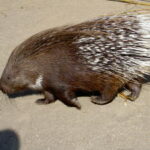Even if you’ve never seen a porcupine live and up-close you know exactly what it is, right? The strange rodent is covered in prickly quills and roams around at night. Generally, the porcupine isn’t a threatening animal; it will usually avoid confrontation. However, if a standoff should occur the porcupine is well able to defend himself. Although many people think that porcupines shoot their quills that’s not true. In fact, the quills are loosely connected and will detach on contact with a person or other animal. The quills have a barb at the end of each one and the barb faces backwards. This makes it difficult to simply pull right back out after attaching itself. As a porcupine attacks it turns its back to the enemy then begins attacking with its quill-covered tail.
As the quill becomes embedded in the dog or other animal the reaction of the muscles cause the barb to work its way deeper and deeper into the muscles. As the muscles flinch and contract the barbed quill continues its journey forward. With the reverse barb it’s nearly impossible to back it out. The quills cause extreme pain and can even cause death, if not treated quickly and properly. Dogs often grab the porcupines in their mouths causing severe injury. In addition, after being injected with the barbed quills, a dog will often paw and claw at them. This makes things even worse. The quills are then driven even deeper into the flesh and muscle.
It’s extremely important that quills be removed immediately. Quills will continue to work their way deeper and deeper into the dog until the event can become a tragedy. Although it’s recommended that the dog be immediately treated by a vet sometimes that is not possible. If you’re hunting with your dog, deep in the woods, there is no time to get him to the vet. Also, after being attacked it can be difficult to get the dog in a lying position. Quills can be sticking out of both sides, mouth, shoulders, limbs and elsewhere. It’s possible that you might have to remove the quills yourself.
It’s not fun being the dog, at this point, but it’s not a picnic for the dog’s owner, either. The quills must be immediately removed and it’s going to be painful and bloody. However, if you want your dog to live you must treat it immediately. You can remove each and every quill or you can remove them all on one side, so you can lay him down, then rush him to the vet. If you’re faced with removing them yourself start by clearing all the quills from one side of the dog.
If the dog has many quills he will need to lie down through the removal process. Grab hold of a pair of pliers – preferably needlenose – and go to work. Work as quickly as you can; the dog is in serious pain. Grab and pull each quill from one side of the dog then lay him down. It might be necessary to tie the dog to a solid object to keep him from trying to run. He’s probably not going to be calm; he’s likely to be yelping and rolling around on the ground in attempt to remove the quills himself.
Work quickly to pull all the quills from one side then settle the dog on that side. Begin remove any quills from the tongue, lips and mouth. If you can’t feel the tip of the quill pull the quill out backwards. However, if you can feel the tip, pull the quill on through. Start with the side you’re going to lay him on, then go on to the mouth and face area, then work on any quills in the shoulder or neck area. Now work on the other side of the dog before worrying with quills embedded in the limbs. The limbs are actually the safest; the quills in the regions of any organs are the largest threat. According to years of vets’ records the quills are most likely to be shot into the head, neck and mouth areas. After you have retrieved any visible quill feel around for additional quills. Check the dogs ears and other areas. Many quills can break off leaving them virtually undetectable.
Even if you’re unable to get your dog to a vet for quill removal, and you end up having to remove them yourself, it’s extremely important that your dog be seen by a vet. Not only could there be quills where you can’t see them or can’t get them removed, but the dog is also at risk for infection. See a vet and get an antibiotic to make sure your dog is protected from infection. Many dogs, whether treated by a vet or by yourself, have complications after the quill removal. Lots of dogs return to the vet with additional quills, skin irritation, mouth inflamation and other problems.
It’s a horrifying sight to see your beloved pet be attacked by a porcupine, but if you act fast, you can keep your dog safe from further injury and infection. When possible, rush the dog to the vet but if that’s not feasible, take mattes into your own hands. It’s not a pleasant job, but if it falls on you to do it, work quickly to help your pet. Try to ignore the yelping and the blood and try to just concentrate on helping your dog; that’s what will get you – and him – through the awful ordeal!
Source: www.peteducation.com
Reference:
- Read more here: www.ncbi.nlm.nih.gov/pmc/articles/PMC1482438/

